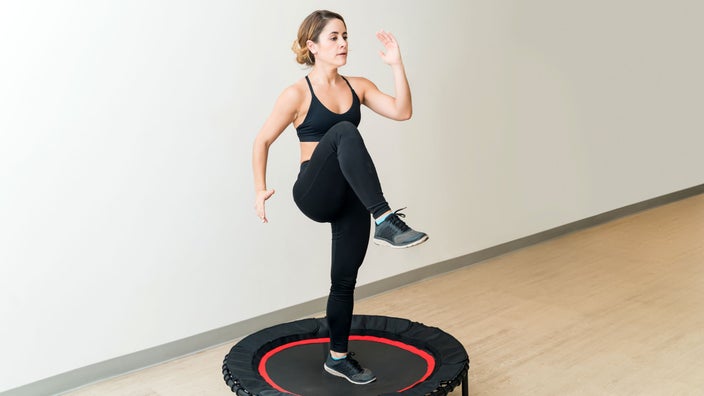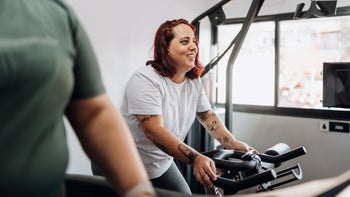
Rebounding Exercises 101: Benefits, Safety, and Mini-Trampoline Workouts to Get You Started
Key takeaways:
Rebounding refers to exercising while jumping on a mini trampoline.
The low-impact exercise can boost your heart health, strengthen your muscles, and improve your balance while protecting your bones and joints.
You can also modify rebounding exercises, making them suitable for both beginners and advanced athletes.

Tired of your usual cardio workouts? Rebounding exercises are a great way to switch up your fitness routine. All you need is a small trampoline (rebounder) to get a fun, heart-pumping aerobic workout. Learn about the benefits of rebounding, exercises, and safety tips before you get started.
What are rebounding exercises?
Rebounding exercise is a low-impact aerobic workout performed on a mini trampoline called a rebounder. It includes various moves –– such as jumping, skipping, and jogging in place –– that can range from relatively low-intensity to more vigorous, high-energy exercises. This versatile training style is easy on your joints because the trampoline provides a soft landing and absorbs shock from jumping.
Benefits of rebounding exercises
The mention of a trampoline might bring back fun childhood memories. But trampolines don’t have to be a thing of the past. Adding them to your fitness routine could offer several advantages. Here are some of the top benefits of rebounding exercise.
Search and compare options
Strengthens muscles
Hopping on a rebounder trampoline is good for your muscles. As you move on an unstable surface, you engage core and lower-body muscles to help maintain balance –– like your abdominals, glutes, and hamstrings. In a small study, women who did an aerobic dance program on a rebounder trampoline had stronger leg muscles and better balance than those who did the same program on a hard wooden surface.
May support pelvic floor health
You might not think about your pelvic floor muscles when choosing muscle-strengthening exercises. But you might want to. These muscles at the bottom of your pelvis are an essential part of your core. And they help support bladder and bowel control, as well as sexual functioning.
Rebound trampoline workouts may strengthen your pelvic floor because bouncing activates these deep core muscles. A small study found that rebounding activated pelvic floor muscles in healthy women. But more research is needed to fully understand how rebounding affects your pelvic floor.
Builds strong bones
Rebounding is a weight-bearing exercise that puts healthy stress on your bones. This stress can help prevent bone loss and lower your risk of fractures. One small-scale study found that competitive trampolinists had better bone density and strength compared to non-trampolinists.
Improves balance and coordination
Staying on your feet while bouncing on a rebounder trampoline also challenges your sense of balance. You strengthen stabilizer muscles as you adjust to the unstable surface, which can lead to better balance.
Mini trampoline workouts have been shown to improve balance and functional mobility in older women. This is especially beneficial for those at higher risk of falls and related injuries.
A rebounder is just one way to improve balance. Exercising on a vibration plate may help, too. The benefits of vibration plates might make you want to shake up your fitness routine.
Looking for more low-impact exercises? Consider taking your workouts to the water with aqua jogging.
Add more variety with cross-training. This training method combines different workouts into one fitness plan. It’s a great way to beat boredom and build total-body fitness. Find out how to start cross-training.
Promote cardiovascular health and fitness
Aerobic exercise improves heart health. And rebounding is no exception. Jumping on a rebounder gets your heart pumping and your blood flowing. These things can improve cardiovascular health.
It may also help build endurance and boost your fitness for other workouts and sports. In a small study, women with larger body sizes completed a 12-week trampoline workout program. At the end of the program, they saw an improvement in aerobic capacity.
Boost your mood
Aerobics can lift your spirits. And what better way to boost your mood than with a trampoline workout?
Read more like this
Explore these related articles, suggested for readers like you.
You might find that rebounding is a fun, playful way to embrace your inner child. And it might not be as tedious as some of your other workouts. In one study, college students did an 8-week rebounding program. Although they did moderate to vigorous intensity exercise, they reported a lower rate of perceived exertion. In other words, rebounding workouts felt less strenuous than they were. The students also reported having fun.
Doing workouts you enjoy can help you stay motivated to exercise.
What are the best rebounding exercises for beginners and pros?
You can do rebounding exercises continuously to build endurance, or in short, high-intensity bursts followed by brief rest periods to boost your strength and speed. This flexibility makes them a great option for people of all fitness levels. Here are nine rebounding exercises to try.
1. Cross countries
This cross-country exercise can also help you get used to trampoline exercises. Think of this move as prancing to encourage light footwork.
Step 1: Stand on the rebounder trampoline with your feet hip-width apart.
Step 2: Jog in place, bouncing lightly on each foot. Try to keep your steps as quick and low as possible.
Step 3: Continue for at least 60 seconds. Gradually increase the time you do this exercise to develop strength and endurance.
2. Rebounder jogging
Jogging is an effective warmup that can help you get comfortable balancing on a rebounder.
Step 1: Stand upright in the center of the rebounder trampoline with your feet hip-width apart.
Step 2: Engage your abs and lift one leg towards your chest as if you’re marching in place.
Step 3: Alternate legs, bringing each knee up as high as you can comfortably. Keep your movements controlled. Pump your arms to help drive your knees up.
3. Bouncing arm raises
Bouncing arm raises are a great way to work both your upper and lower body while testing your coordination skills.
Step 1: Stand up straight on the rebounder with your feet hip-width apart, arms at your sides, and core engaged.
Step 2: Bounce up and down on the trampoline.
Step 3: While continuing to bounce, extend your arms straight out in front of you and then out to your sides.
Step 4: Keep your arms straight as you bring them back in front of you and then down to your sides. Keep bouncing as you repeat the arm movements.
Step 5: Continue for 30-60 seconds.
4. Squats
You can also do bodyweight exercises like squats on a rebounder trampoline. The unsteady surface of a rebounder may engage smaller muscles to help stabilize your body.
Step 1: Stand tall with your feet about hip-width apart.
Step 2: Engage your core as you lower your hips toward the rebounder. Make sure your knees don’t pass your ankles.
Step 3: Pause and hold the squat for 5 seconds. Then, push through your heels to return to standing.
Step 4: Repeat 10-15 times, moving slowly and with control.
5. Twist jumps
The twist jump is a core-strengthening and calorie-burning exercise. It activates your abs and obliques, as well as lower back and leg muscles.
Step 1: Stand on the rebounder with your core engaged, feet hip-width apart, and knees slightly bent.
Step 2: Extend your arms to the sides with your palms facing down.
Step 3: Jump and twist your hips to the right, while keeping your upper body facing forward. Land softly with your feet toward the right.
Step 4: Repeat on the other side by jumping and twisting your hips to the left. Keep your upper body centered and land with your feet toward the left.
Step 5: Keep jumping and twisting your hips with each bounce for 30-60 seconds.
6. High knees
Once you’ve mastered marching, jogging, and jumping on a rebounder, you can progress to more challenging exercises like high knees. It requires coordination, agility, and footwork skills.
Step 1: Stand on the rebounder with your legs hip-width apart.
Step 2: Engage your core as you drive your right knee towards your chest and pump your arms vigorously.
Step 3: Switch legs, placing your right foot back on the rebounder and bringing your left knee toward your chest.
Step 4: Keep alternating legs for 30-60 seconds, sprinting as fast as you can and landing on the balls of your feet.
7. Single-leg hops
Single-leg hops challenge your balance and may help strengthen your glutes, quads, and hamstrings.
Step 1: Stand tall on the rebounder. Your feet should be hip-width apart, your core engaged, and your gaze forward.
Step 2: Swing your left arm forward (as if running) and lift your right leg off the rebounder, bouncing up and down on your left leg twice.
Step 3: Switch to the other side, swinging your right arm forward while bouncing on your right leg. Keep your joints stacked on your supporting leg to align your ankle, knee, and hip.
Step 4: Keep alternating single-leg hops for 30 seconds.
8. Speed skaters
The speed skater is another advanced move that requires balance and agility. It works your glutes, quadriceps, hamstrings, and calves.
Step 1: Stand on the rebounder with your core engaged, feet shoulder-width apart, and knees slightly bent.
Step 2: Shift your weight to the right side. Push off your right foot as you jump to the left. Land softly on your left foot while bending your right leg behind you. You can swing your arms as if running.
Step 3: Push off your left foot and jump to the right, landing softly on your right foot.
Step 5: Continue jumping right and left for 30-60 seconds.
9. Jump squats
A jump squat is a plyometric exercise that builds muscle strength, power, and cardio fitness. The trampoline offers some give when you land, which protects your joints.
Step 1: Stand on the rebounder with your feet slightly wider than shoulder-width apart, and engage your core and glutes. Keep your arms at your sides.
Step 2: Do a squat by bending your knees and sitting your hips back (like sitting in a chair) while driving your arms forward.
Step 3: Push through your heels to jump as high as you can, straightening your knees and hips. Use your arms to power the jump.
Step 4: Bend your knees to cushion your landing and immediately go into a full squat to begin the cycle again. Move quickly and powerfully with each repetition.
Step 5: Complete 10-15 reps.
Rebounding safety tips
Safety is important with any exercise, so make sure you follow helpful safety guidelines when doing rebounding exercises.
These safety tips can help guide your trampoline workouts:
Check with a healthcare professional first. Certain people –– such as those who are pregnant or have balance disorders, spine conditions, or injuries –– may need to avoid using a rebound trampoline. A healthcare professional can tell you if rebounding is suitable for you.
Assemble your trampoline properly. You can find rebound trampolines at sporting goods stores and online. Make sure the trampoline is assembled correctly and placed on a steady, level surface.
Check your rebound trampoline before each use. Always make sure the legs are secure before hopping on a rebounder. You should also make sure nothing is underneath it and that you have enough room above you, and to your sides to jump.
Consider using a safety bar. Many rebound trampolines come with a safety bar. It’s helpful for beginners and those who may need extra stability. You can also use a sports strap while rebounding if you wear glasses.
Choose your trampoline workouts carefully. Try to include rebounding exercises that suit your fitness level and goals. Don’t attempt any flips, somersaults, or upside-down maneuvers.
Listen to your body. Stop your trampoline workout if any exercises cause pain, nausea, or dizziness.
The bottom line
Rebounding exercises can be as fun and engaging as they are challenging and gentle on your joints. They’ve been shown to strengthen muscles, improve balance, and burn calories. When done correctly, trampoline workouts are a safe way to boost your health and fitness.
Why trust our experts?



References
Burandt, P., et al. (2016). Putting mini-trampolines to the test. American Council on Exercise ProSource.
Burt, L. A., et al. (2016). Competitive trampolining influences trabecular bone structure, bone size, and bone strength. Journal of Sport and Health Science.
Centers for Disease Control and Prevention. (2024). Facts about falls.
Cugusi, L., et al. (2018). Effects of a mini-trampoline rebounding exercise program on functional parameters, body composition and quality of life in overweight women. Journal of Sports Medicine and Physical Fitness.
Full Control. (2020). Bouncing arm raise [video]. YouTube.
Full Control. (2020). Trampoline squats [video]. YouTube.
Full Control. (2020). Trampoline squat jumps [video]. YouTube.
Full Control. (2020). Trampoline twist jumps [video]. YouTube.
Full Control. (2020). Trampoline walking [video]. YouTube.
Heijnen, S., et al. (2016). Neuromodulation of aerobic exercise—a review. Frontiers in Psychology.
Höchsmann, C., et al. (2018). Oxygen uptake during mini trampoline exercise in normal-weight, endurance-trained adults and in overweight-obese, inactive adults: A proof-of-concept study. European Journal of Sport Science.
JumpSportFitness. (2012). High knee jogging – JumpSport Fitness trampoline exercise [video]. YouTube.
JumpSportFitness. (2013). JumpSport Fitness trampoline workouts – cross countries [video]. YouTube.
JumpSportFitness. (2013). JumpSport Fitness trampoline workouts – speed skaters [video]. YouTube.
JumpSportFitness. (2013). JumpSport Fitness trampoline workouts – twists [video]. YouTube.
McGlone, C., et al. (2002). Rebounding: A low-impact exercise alternative. American College of Sports Medicine’s Health and Fitness Journal.
National Institute of Arthritis and Musculoskeletal and Skin Diseases. (2023). Exercise for your bone health.
Posch, M., et al. (2019). Effectiveness of a mini-trampoline training program on balance and functional mobility, gait performance, strength, fear of falling and bone mineral density in older women with osteopenia. Clinical Interventions in Aging.
Saeuberli, P. W., et al. (2018). Reflex activity of pelvic floor muscles during drop landings and mini-trampolining-exploratory study. International Urogynecology Journal.
Sukkeaw, W., et al. (2015). A comparison between the effects of aerobic dance training on mini-trampoline and hard wooden surface on bone resorption, health-related physical fitness, balance, and foot plantar pressure in Thai working women. Journal of the Medical Association of Thailand.
Witassek, C., et al. (2018). The effect of several weeks of training with mini-trampolines on jump performance, trunk strength and endurance performance. German Journal of Sports Medicine.




























